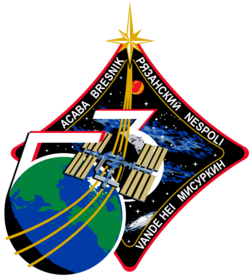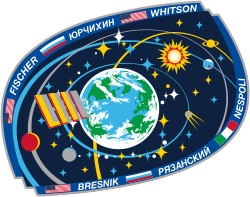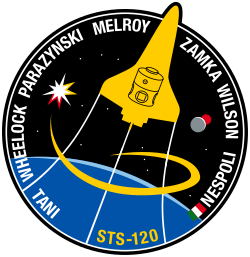Paolo A. Nespoli
| Paolo Angelo Nespoli | |
 | |
| ESA - Astronaut | |
|---|---|
| Född | 6 april 1957 |
| Tid i rymden | 313 dygn, 2 timmar, 36 minuter |
| Urvalsgrupp | 1998 ESA |
| Uppdrag | STS-120, Sojuz TMA-20, Expedition 26 / 27, Sojuz MS-05, Expedition 52 / 53 |
| Uppdragsemblem | |
Paolo Angelo Nespoli, född 6 april 1957 i Milano, är en italiensk astronaut (ESA), uttagen i astronautgrupp 17 1998.
Asteroiden 12405 Nespoli är uppkallad efter honom.[1]
Rymdfärder
Externa länkar
Referenser
- ^ ”Minor Planet Center 12405 Nespoli” (på engelska). Minor Planet Center. https://www.minorplanetcenter.net/db_search/show_object?object_id=12405. Läst 16 november 2022.
|
Media som används på denna webbplats
The Expedition 53 crew insignia
- The International Space Station is our launch pad into the future of human space exploration. Collectively, our world stands at the cusp of incredible developments as a spacefaring species. Onboard the space station we continue to evolve the technologies vital to the sustainment and longevity of humans in the harsh realities of living without gravity or the protection of our atmosphere. These self-sustaining or regenerative technologies continually developed aboard the space station not only improve life here on Earth, but they are essential to human beings existence beyond low-Earth orbit (LEO).
- The space station is the linchpin for this next great phase of development and is instrumental in expanding the use of space, not only as a worldclass science laboratory, but also as a destination for next-generation space vehicles. This journey beyond LEO is depicted in the Expedition 53 patch as we, the crew, will endeavor to accomplish the work that allows future missions to further explore our solar system. This journey will only be accomplished as an international team, represented by our multinational crew as well as by the many countries depicted on the globe.
- The myriad of stars represent the untold number of passionate and supremely dedicated people that endeavor across the planet daily to make the space station the amazing vehicle it is as well as prepare us for the next great steps forward in space exploration.
The Expedition 52 crew insignia
- Our planet is shown surrounded by an imaginary constellation shaped like a house, depicting the theme of the patch: “The Earth is our home.” It is our precious cradle, to be preserved for all future generations. The house of stars just touches the Moon, acknowledging the first steps we have already taken there, while Mars is not far away, just beyond the International Space Station, symbolized by the Roman numeral “LII,” signifying the expedition number.
- The planets Saturn and Jupiter, seen orbiting farther away, symbolize humanity’s exploration of deeper space, which will begin soon. A small Sputnik is seen circling the Earth on the same orbit with the ISS, bridging the beginning of our cosmic quest till now: Expedition 52 will launch in 2017, sixty years after that first satellite.
- Two groups of crew names signify the pair of Soyuz vehicles that will launch the astronauts of Expedition 52 to the Station.
In the foreground of the patch, the International Space Station is prominently displayed to acknowledge the efforts of the entire International Space Station (ISS) team - both the crews who have built and operated it, and the team of scientists, engineers, and support personnel on Earth who have provided a foundation for each successful mission. Their efforts and accomplishments have demonstrated the space station's capabilities as a technology test bed and a science laboratory, as well as a path to the human exploration of our solar system and beyond. The ISS is shown with the European Space Agency's (ESA) Automated Transfer Vehicle (ATV-2), the Johannes Kepler, docked to resupply it with experiments, food, water, and fuel for Expedition 26 and beyond. This Expedition 26 patch represents the teamwork among the international partners - USA, Russia, Japan, Canada, and the ESA - and the ongoing commitment from each partner to build, improve, and utilize the ISS. Prominently displayed in the background is our home planet, Earth - the focus of much of our exploration and research on our outpost in space. The two stars symbolize two Soyuz spacecraft, each one carrying a three-member crew, who for four months will work and live together aboard the ISS as Expedition 26. The patch shows the crewmembers' names, and it's framed with the flags of their countries of origin - United States, Russia, and Italy.
The STS-120 patch reflects the role of the mission in the future of the space program. The shuttle payload bay carries Node 2, the doorway to the future international laboratory elements on the International Space Station. On the left the star represents the International Space Station; the red colored points represent the current location of the P6 solar array, furled and awaiting relocation when the crew arrives. During the mission, the crew will move P6 to its final home at the end of the port truss. The gold points represent the P6 solar array in its new location, unfurled and producing power for science and life support. On the right, the moon and Mars can be seen representing the future of NASA. The constellation Orion rises in the background, symbolizing NASA's new exploration vehicle. Through all, the shuttle rises up and away, leading the way to the future.
The Expedition 27 patch depicts the International Space Station (ISS) prominently orbiting Earth, continuing its mission for science, technology and education. The ISS is an ever-present reminder of the cooperation between the United States, Russia, Japan, Canada, and the European Space Agency (ESA) – and of the scientific, technical, and cultural achievements that have resulted from that unique teamwork. The ISS is shown in its completed status with the latest addition of the Alpha Magnetic Spectrometer (AMS), and with two resupply vehicles docked at each end of the station. The Southern Cross Constellation is also show in the foreground and its five stars, along with the sun, symbolize the six international crew members that live and work on the space station. The Southern Cross is one of the smallest modern constellations, and also one of the most distinctive. It has cultural significance all over the world and inspires teams to push the boundaries of their worlds, both in space and on the ground.






